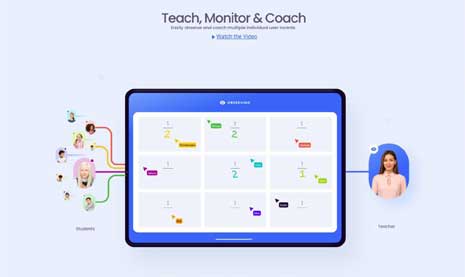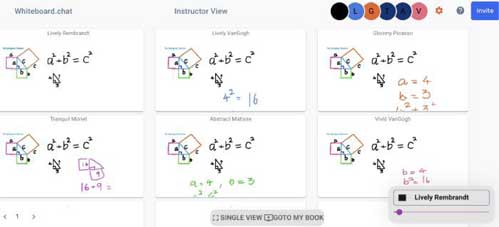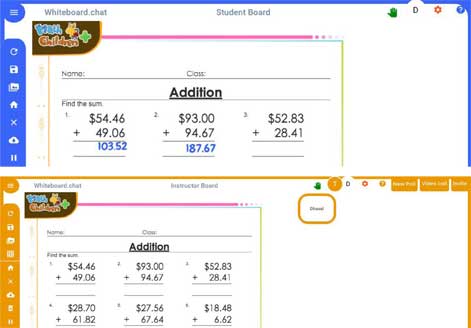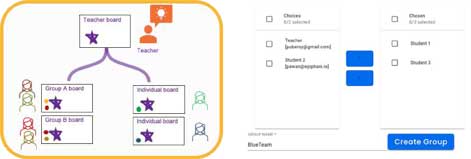Dhaval Shah
The pandemic induced forced adoption of remote learning across the world has created tremendous challenges for both teachers and students. As parents and technologists from Silicon Valley, my colleagues and I have witnessed teachers struggle to teach remotely, and our children wanting to continue to learn in an in-class environment, but virtually.
The existing technological solutions did help teachers and students up to a certain level, but from what we learnt from teachers, students and parents, more work is needed to simulate a classroom environment in a remote learning set-up.
Let’s quickly look at what usually happens in a classroom. This is a highly generic example.
- A teacher distributes worksheets or other material to students.
- Teacher uses a white or blackboard to teach/draw/write and students follow using their worksheets/notebooks and the instructions.
- Teacher walks around the classroom to look at students’ notebooks to see what they are doing and guide them if needed.
- Students raise their hands when they need the teacher’s attention and get personalized, individual feedback or assistance.
- Many times a teacher splits the class in multiple sub-groups for projects and other collaborative work.
- Teachers may also give out rapid quizzes or show videos or other material followed by a collaborative discussion on the learning.
Learning in a classroom is not only instructional, but also highly interactive and collaborative in a one-to-many, one-on-one and sometimes many-to-one flipped setting.
Due to the pandemic, overnight teachers were forced to adopt and adapt technological tools primarily designed for business purposes and team collaboration, for teaching. What most of these tools lack is a way for the teacher to have that one-to-many real-time visibility into what their students are learning, and for students to get personalized help when they need it. These tools also lack a way for students to work individually, in their own virtual notebooks, without sharing it with other students. These tools don’t have the ability to break participants into sub-groups, enable them to share their virtual notebooks to collaborate, and go back to individual work either.
Introducing Whiteboard.Chat: A virtual whiteboard designed from groundup for remote teaching.

We talked to teachers, students, parents and researched and designed a virtual whiteboard on the principles of human-centric design thinking, keeping teachers needs at the center of our design.
We have recently released a completely free to use virtual web-based whiteboard at https://www.whiteboard.chat. It does not require any download or set-up, all you need is a browser in any device with internet connectivity. We have also kept in mind low bandwidth requirements to ensure uniform performance across varieties of devices/internet conditions. We have also been very mindful of privacy concerns and hence no sign-up is required from teachers or students. All you need to do is to point your browser to whiteboard.chat and get started.
From the beginning, our focus has been to simulate in-class experience as much as possible and give both students and teachers the tools they need for effective, highly satisfying learning, remotely. Here’s how Whiteboard.Chat enables it
- After creating a whiteboard, a teacher can invite students by simply pasting the link in Google Classroom, Zoom Chat, Whatsapp, email or any other communication platform. Students do not need to sign-up. They simply click the link to join. As students join, a teacher can use the grid view to see all students’ boards in real time, just like he/she would in a classroom setting. Students see what the teacher is writing/drawing/teaching and can work on their worksheets individually on their boards. No student can see the other student’s board. Only the teacher has full visibility, again simulating the in-class experience.

- A teacher can upload worksheets as pdf or images clicked using his/her phone camera, and students can directly work on the sheets in their boards. They can raise their hands which will send a notification to the teacher and the teacher can join the student’s board and provide them individualized feedback/assistance.

The above shows how a student can raise their hand and how the notification showed up on the teacher’s board. The teacher can directly click on the notification to goto that student’s board and help out.
● A teacher can create break-out rooms, and assign students to groups, observe their progress and help students collaborate.

Above is how a teacher can create groups. Once created, the students will have two boards to work on – their individual board and the combined, collaborative group board. They can switch back and forth as needed. And the teacher will be able to see both, group boards and students’ individual boards, again simulating in-class experience.
We have many more features like creating polls, sending links to videos, etc., with the facility to see if the students actually opened those links and watched the material provided. We have also made it easy to integrate whiteboard.chat with video conferencing of their choice – Zoom, Google Meet, etc. We also have in-built video conferencing for those who may not have a Zoom subscription. Here is a link to an explanatory video that covers many features of whiteboard.chat. You can also access our collection of helpful articles and other videos at https://www.whiteboard.chat/help.
We are actively talking to teachers across the world, collecting their valuable feedback and improving their remote learning experience. We are passionate and committed to what we do. Remote learning has been around even before the pandemic hit the world. But the push for remote learning on such a wide scale has had an effect of changing people’s behaviours and it has also shown how beneficial it can be for the larger population. Imagine a teacher in the US or India, able to teach students anywhere in the world, who otherwise may not have access to quality education. We believe virtual classrooms can truly democratize quality education and technology has a vital role to play in enabling students and teachers to learn effectively without missing out on in-class experience.
Follow us at Facebook, Instagram and Twitter and do send your valuable feedback at feedback@whiteboard.chat.
The author is a Human-centric Systems Designer and a Technologist with 20 years of experience in Silicon Valley and India. He is passionate about addressing our complex social and business challenges. He leads design and marketing at Epiphani, a Silicon Valley start-up behind Whiteboard.Chat. He can be reached at dhaval@epiphani.io.
